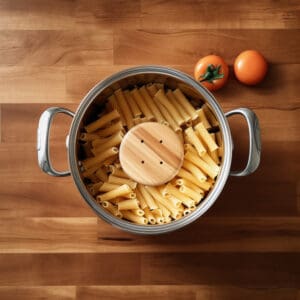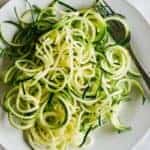
KEY TAKEAWAY
Can you use a pasta pot as a steamer?
You can use a pasta pot as a steamer with some simple modifications and the right techniques.It’s a versatile and convenient kitchen tool that can help you cook healthy and delicious meals.
What is a pasta pot and how does it work as a steamer?

If you’re looking for a way to cook your food using a pot that’s versatile and efficient, then you might be interested in learning about how a pasta pot can double as a steamer.
A pasta pot (1) is simply a large pot with a strainer insert that fits inside it.
The purpose of the strainer is to lift out the cooked pasta once it’s done cooking.
However, what many people don’t realize is that this same strainer insert can also be used as a steamer basket.
By filling the bottom of the pot with water and placing vegetables or other foods in the strainer, you can steam your meal quickly and easily.
The perforations in the strainer allow steam to circulate around the food, cooking it evenly without having to submerge it in boiling water.
One of the benefits of using a pasta pot as a steamer is that it saves space in your kitchen by eliminating the need for an additional appliance.
Additionally, many pasta pots come with handles on both sides of the pot itself as well as on the strainer insert, making them easy to handle even when full of hot water or food.
Overall, if you’re looking for an affordable and practical way to steam your meals at home, consider investing in a pasta pot with a built-in steamer insert.
What are the key considerations before buying a pasta pot for steaming?
Before you buy a pasta pot for your steaming needs, there are key factors you should consider to ensure it meets all your requirements.Firstly, think about the size and type of pasta you will be cooking.If you mostly cook small kinds of pasta like macaroni or penne, then a smaller sized pot may suffice.However, if you prefer larger types of pasta like spaghetti or linguine, then a bigger pot with a strainer insert would be more appropriate.Secondly, look for additional features that can enhance your steaming experience.Some pasta pots come with warranty periods which can give you peace of mind in case something goes wrong with the product.Others have built-in drainage systems that make it easier to empty water from the pot after boiling.Lastly, read some pasta pots reviews online to get an idea of what other customers have experienced with different brands and models.You can find out more about the durability and usability of each product before making your final decision.So are pasta pots worth it? Check it out here.If after purchasing your pasta pot for steaming and using it several times, you find that it’s not working properly, there are ways to fix this issue without buying a new one altogether.In the next section, we will discuss some tips on how to troubleshoot common problems when using a pasta pot as a steamer.
How can you fix your pasta pot for steaming if it’s not working properly?
Don’t let your kitchen tools go to waste – if your oval-shaped pasta pot with a strainer lid and stainless steel handles isn’t boiling water like a watched pot should, it’s time to roll up your sleeves and troubleshoot.First, make sure you’re using the correct type of pot for steaming.While some pasta pots may have a built-in strainer for convenience, they may not be suitable for steaming because they lack proper ventilation.Look for a pot with multiple small holes at the bottom to allow steam to seep through.Next, check that the water level is sufficient.Steaming requires enough moisture in the pot to create steam and cook food evenly.Measure out the appropriate amount of water based on how much food you plan on steaming – typically 1-2 cups of water per batch works well.If there isn’t enough water, add more until it reaches just below the bottom of the steamer basket or tray.Lastly, ensure that your pasta pot is clean and free of debris that can clog up the ventilation holes or interfere with heat distribution.Use warm soapy water and a non-abrasive sponge or cloth to gently scrub away any stubborn stains or residue.Rinse thoroughly with hot water before using it again as a steamer.Now that you’ve fixed your pasta pot for steaming, it’s time to put it into action!If you want more information about how to use pasta pot, you can check it out.In the next section, we’ll explore what veggies you can steam in a pasta pot for a quick and healthy meal without sacrificing flavor or nutrition.
What veggies can you steam in a pasta pot for a quick and healthy meal?
 Looking for a quick and healthy meal? You can easily steam a variety of veggies in your pasta pot with a steamer insert. (2)It’s an ideal pasta pot that can double as a steamer to provide you with delicious, nutritious meals in no time.To start, fill the pot with enough water so it doesn’t touch the bottom of the steamer insert.Bring the water to a boil before adding your veggies.Once they’re added, cover them with a lid to keep in all the steam and let them cook until they’re tender but still crisp.You may also want to add a bit of pasta water or broth for extra flavor.Some great veggies to steam include broccoli, carrots, green beans, zucchini, and cauliflower.Plus, steaming helps retain more nutrients than boiling them does.Experiment with different combinations or seasonings to create your own unique dish that fits your personal preference.Incorporating more vegetables into your diet doesn’t have to be difficult or time-consuming when using your trusty pasta pot as a steamer.Try out this simple method today for an effortless way to enjoy fresh and flavorful veggies at every meal!Next up: what’re some basic tips for using a pasta pot as a steamer?
Looking for a quick and healthy meal? You can easily steam a variety of veggies in your pasta pot with a steamer insert. (2)It’s an ideal pasta pot that can double as a steamer to provide you with delicious, nutritious meals in no time.To start, fill the pot with enough water so it doesn’t touch the bottom of the steamer insert.Bring the water to a boil before adding your veggies.Once they’re added, cover them with a lid to keep in all the steam and let them cook until they’re tender but still crisp.You may also want to add a bit of pasta water or broth for extra flavor.Some great veggies to steam include broccoli, carrots, green beans, zucchini, and cauliflower.Plus, steaming helps retain more nutrients than boiling them does.Experiment with different combinations or seasonings to create your own unique dish that fits your personal preference.Incorporating more vegetables into your diet doesn’t have to be difficult or time-consuming when using your trusty pasta pot as a steamer.Try out this simple method today for an effortless way to enjoy fresh and flavorful veggies at every meal!Next up: what’re some basic tips for using a pasta pot as a steamer?
What are the basic tips for using a pasta pot as a steamer?
Get ready to transform your pasta pot into a magical vegetable steaming machine with these simple tips that’ll blow your mind!First and foremost, fill the pasta pot with enough water so that it reaches just below the bottom of the steamer basket.Turn up the heat and let the water come to a boil before adding in your veggies.Once you have added in your vegetables, cover them with a lid and let them steam for approximately 5-7 minutes.For best results, use a timer to ensure that they’re not overcooked or undercooked.Here’s a list of vegetables that work great when steamed in a pasta pot:
- Broccoli
- Carrots
- Cauliflower
- Green beans
Remember to check on your veggies periodically by lifting up the lid, but be careful not to let too much steam escape as it’ll slow down the cooking process.Using your pasta pot as a steamer is an excellent way to create healthy veggie-packed meals without sacrificing any flavor or texture.However, keep in mind that not all pasta pots are created equal when it comes to using them as steamers.In the next section, we’ll explore what type of pot is best for cooking pasta and steaming veggies so you can make an informed decision when choosing which one to buy for your kitchen arsenal!
What type of pot is best for cooking pasta and steaming veggies?

Moving on to the next question on your mind, let’s talk about what type of pot is best for cooking pasta (3) and steaming veggies.While you can certainly use a pasta pot for both purposes, some types of pots are better suited for each task.When it comes to cooking pasta, you want a pot that is large enough to hold plenty of water and has a tight-fitting lid.Aluminum pots are great for this purpose because they heat up quickly and evenly, allowing your water to come to a boil faster.Look for one with an aluminum base or disc for added durability, or opt for hard-anodized aluminum construction if you’re willing to splurge.For steaming veggies, you’ll want something with a perforated insert or basket that fits snugly inside your pot.This allows the steam from the boiling water below to cook your vegetables without getting them wet or soggy.Stainless steel pots with aluminum cores are ideal because they retain heat well and won’t react with acidic foods like tomatoes or vinegar-based marinades.Now that you know which type of pot is best suited for each task, let’s move on to another common question: should you rinse pasta before or after cooking it in a pasta pot?
Should you rinse pasta before or after cooking it in a pasta pot?
Don’t ruin your perfect pasta dish by rinsing it before or after cooking – trust the experts and skip the rinse!When cooking pasta in a pasta pot, you want to ensure that you are using enough boiling water to fully submerge the noodles.This will help prevent them from sticking together and ensure an even cook.Once the pasta is cooked to your desired level of tenderness, simply drain the water using the built-in strainer in your pasta pot.Some people believe that rinsing pasta after cooking can remove excess starch and prevent it from becoming too sticky.However, this step is not necessary when using a pasta pot for cooking.The boiling water helps remove any excess starch during the cooking process, leaving you with perfectly cooked noodles every time.Plus, skipping the rinse saves time and extra steps in your recipe.When it comes to cleaning up after a delicious meal, many wonder if their pasta pot is dishwasher safe.Most high-quality pasta pots are designed for easy cleaning and can be safely washed in the dishwasher.Just be sure to check the manufacturer’s instructions before putting it in for a spin.By following these tips for perfect pasta cooking in a dedicated pot, you’ll have fewer dishes to clean up afterwards!Now that you know how to cook perfect pasta without rinsing it first or lastly washing up with ease thanks to your dishwasher safe pan, let’s take things one step further – can you put a pasta pot in the oven for baking or roasting?
Can you put a pasta pot in the oven for baking or roasting?
Can’t decide between baking or roasting your favorite dish? Before you toss that pasta pot in the oven, it’s important to investigate whether your high-performing cookware has this exotic and attractive feature.While a pasta pot is primarily designed for cooking pasta, it can also be used for other purposes like steaming vegetables, poaching eggs, and even baking or roasting certain dishes.Here are some things to consider when using a pasta pot in the oven:– Material: Check if your pasta pot is made of materials that are oven-safe such as stainless steel or cast iron.– Handles: Make sure that the handles on your pasta pot are also oven-safe so they won’t melt or burn when exposed to high temperatures.– Capacity: Consider the size of your pasta pot and if it can accommodate the dish you want to bake or roast.– Lid: Check if your pasta pot comes with a lid that fits tightly so it can help retain moisture while cooking.In conclusion, using a pasta pot in the oven can be convenient and versatile but make sure to check its features before doing so.Not all pots are created equal and not all pots are designed for high heat applications.With proper care and usage, you can explore more ways to use your trusty kitchen companion beyond boiling water for spaghetti.
Conclusion
So, can you use a pasta pot as a steamer? The answer is yes!With a few simple modifications and some basic tips, you can turn your trusty pasta pot into an efficient tool for steaming vegetables and other foods.Just remember to choose the right type of pasta pot for the job, make sure it’s in good condition, and follow the proper techniques for successful steaming.For example, try using a stainless steel or aluminum pot with a tight-fitting lid and sturdy handles.And don’t forget to add enough water to create steam without boiling over or drying out your food.A great real-life example of this would be using your pasta pot to steam broccoli florets while cooking some whole wheat spaghetti in another pan.Once both are cooked to perfection, mix them together with some olive oil and grated Parmesan cheese for a healthy and delicious meal that’s ready in minutes.So next time you’re looking for an easy way to cook up some veggies, give your pasta pot a try!
Frequently Asked Questions
Is it safe to use a pasta pot as a steamer?
Are you one of those who likes to get creative in the kitchen? Do you have a pasta pot lying around and want to mix things up? Well, you’re in luck because a pasta pot can double up as a steamer! But hold your horses, cooking can be a tricky thing, so we’ve got some tips to keep you safe.First off, take out the colander from the pasta pot.Fill the pot with some water, just enough to cover the base, but not enough to touch the steamer basket.Make sure the steamer basket fits snugly on top of the pot, like a hat on a head.Cover the pot with a glass lid, so you can peek inside.If you’re feeling fancy, you could get an oval-shaped pot and impress your cooking experts!Get the pot of water boiling before you put the food in the steamer basket.Once the water starts bubbling, add in your fresh pasta or any other food you want to steam.It’s like cooking pasta dinners, but with a twist.Let the steam do its magic and cook your food until it’s perfectly done.Remember to use non-stick pasta pots so the pasta doesn’t stick to the bottom.And don’t forget to use a pasta insert to make sure you don’t overcook the pasta after cooking it.You can use your pasta steamer to cook anything from veggies to fish, from pasta to party appetizers.And the best part? You can have pasta with plenty of texture and flavor without adding any extra oil or fat.So, what are you waiting for? Get creative in the kitchen and give your pasta pot a new lease on life!
How do you prevent food from sticking to the steamer basket in a pasta pot?
Now, let’s talk about how to prevent food from sticking to the steamer basket.One of the best ways to prevent food from sticking is to use oil or cooking spray on the basket.You can also use parchment paper or a banana leaf on the basket to prevent food from sticking.Another tip is to make sure that the food is not overcrowded in the basket.Overcrowding can cause the food to stick together and prevent it from cooking evenly.In conclusion, using a pasta pot as a steamer is safe and easy, but it requires some caution.Make sure to use the correct amount of water, secure the steamer basket correctly, and prevent food from sticking to the basket.With these tips, you can now enjoy steaming your favorite foods in your pasta pot without any worries!
Can you use a pasta pot as a double boiler for melting chocolate or making custard?
You know that old saying, necessity is the mother of invention? Well, that’s certainly true when it comes to cooking.Sometimes, you just don’t have the right equipment on hand to make a recipe, but you can improvise with what you do have.If you don’t have a double boiler to melt chocolate or make the custard, you might be wondering if you can use a pasta pot instead.The answer is, yes, you can!To use a pasta pot as a double boiler, simply fill the bottom of the pot with water and bring it to a boil.Then, place a heat-proof bowl on top of the pot, making sure it’s not touching the water.Add your chocolate or custard ingredients to the bowl and stir until melted or cooked.It’s important to note that you should use a heat-proof bowl made of glass or metal, and not plastic.Also, be sure to keep an eye on the water level in the pasta pot and add more as needed to prevent it from boiling dry.Overall, using a pasta pot as a double boiler is a great hack for those times when you don’t have a dedicated double boiler on hand.However, if you plan on doing a lot of cooking that requires a double boiler, it might be worth investing in one to make the process easier and more efficient.
What are the best recipes to make using a pasta pot as a steamer?
When it comes to cooking Asian cuisine, steaming is a popular method that’s used to cook everything from dumplings to fish.While there are dedicated steamers available, if you don’t have one on hand, you can use a pasta pot as a steamer instead.Here are some of the best recipes to make using a pasta pot as a steamer:
- Steamed dumplings: Whether you’re making pork, chicken, or vegetable dumplings, steaming them in a pasta pot is a great way to cook them.
Simply place the dumplings on a heat-proof plate or steaming basket and place it on top of the pot.Steam for 8-10 minutes or until cooked through.
- Steamed fish: For a healthy and flavorful way to cook fish, try steaming it in a pasta pot.
Place the fish on a heat-proof plate or steaming basket and place it on top of the pot.Steam for 10-15 minutes or until cooked through.
- Steamed buns: Also known as bao buns, these fluffy and delicious buns are a staple in Asian cuisine.
To make them, place the buns on a heat-proof plate or steaming basket and place it on top of the pot.Steam for 10-15 minutes or until heated through.Overall, using a pasta pot as a steamer is a great way to cook a variety of Asian dishes.Just be sure to use a heat-proof plate or steaming basket and keep an eye on the water level in the pot to prevent it from boiling dry.
References
- https://www.foodnetwork.com/fn-dish/recipes/2019/12/why-you-need-pasta-pot
- https://kalejunkie.com/how-to-steam-your-veggies-and-cook-pasta-at-the-same-time/
- https://en.wikipedia.org/wiki/Pasta
Related Articles
- https://milkwoodrestaurant.com/are-pasta-pots-worth-it/
- https://milkwoodrestaurant.com/pasta-pots/
- https://milkwoodrestaurant.com/how-to-use-a-pasta-pot/
Was this helpful?
Hi there! I’m a food enthusiast and journalist, and I have a real passion for food that goes beyond the kitchen. I love my dream job and I’m lucky enough to be able to share my knowledge with readers of several large media outlets. My specialty is writing engaging food-related content, and I take pride in being able to connect with my audience. I’m known for my creativity in the kitchen, and I’m confident that I can be the perfect guide for anyone looking to take their culinary journey to the next level.







